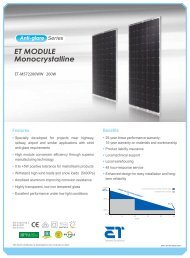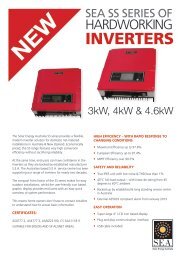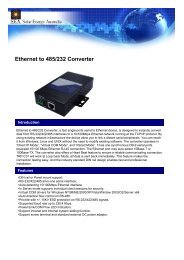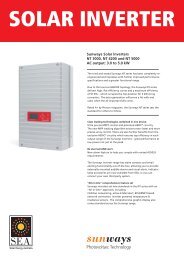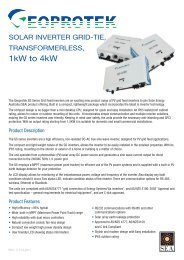Compact Manual 0303 - Solar Energy Australia
Compact Manual 0303 - Solar Energy Australia
Compact Manual 0303 - Solar Energy Australia
You also want an ePaper? Increase the reach of your titles
YUMPU automatically turns print PDFs into web optimized ePapers that Google loves.
<strong>Solar</strong> <strong>Energy</strong> <strong>Australia</strong><br />
<strong>Compact</strong><br />
(b)<br />
Push buttons<br />
ON/OFF<br />
RESET<br />
Aux. Contact<br />
Turning the COMPACT on and off (Help Button for Programming)<br />
Press to turn OFF Alarm Signal. (Help Button for Programming)<br />
<strong>Manual</strong>ly activates the Auxiliary contact. (Help Button for Programming)<br />
(c)<br />
Turning Knobs<br />
CHARGER<br />
TRANSFER<br />
STANDBY<br />
INPUT LIMIT<br />
Adjustment for max. Charging Current (Not for <strong>Solar</strong> charge regulator)<br />
Adjustment for Transfer Voltage Threshold(TRANSFER – INVERTER)<br />
Adjustment for “Standby“ system<br />
Must be adjusted to the maximal available current of your AC INPUT supply (see separate<br />
chapter for further information)<br />
The Inverter<br />
The Inverter section of the COMPACT produces a high quality Sinewave output, the quality of this output is compatible<br />
with any appliance. Thanks to the generous dimensioning of the COMPACT, you can operate appliances requiring higher<br />
power than the nominal power of the COMPACT for a short time. The COMPACT provide up to 3-times the nominal<br />
power to start motors etc.<br />
The Inverter mode is displayed through LED marked “Inverter” If the Inverter Mode is disabled (see elsewhere in this manual)<br />
this LED will blink. If the LED is lit, the Inverter is in operation and you have 230Vac at output AC OUT. The actual<br />
power consumption of the AC load is displayed on the power monitor and on the remote display.<br />
(a) Load detection system “Standby“<br />
In order to avoid unnecessary discharge of the battery, the inverter switches OFF automatically if no AC power is being<br />
used. The <strong>Compact</strong> switches ON automatically again if an AC load is switched ON. The AC Out LED blinks if the inverter<br />
is in Standby-Mode. The switching-ON threshold can be adjusted with the “STANDBY” adjustment dial. Adjusting the<br />
switching-on level is done using a small screwdriver as follows: Switch off all AC loads; turn the “Standby” dial to the right<br />
until the AC Out is blinking, switch on the smallest AC load (i.e. Mobile phone charger); turn the “Standby” dial slowly to<br />
the left until the AC Out LED is lit.<br />
If the Standby- Mode is not wanted, turn the “Standby” dial to the left, to the OFF position, this will keep the <strong>Compact</strong><br />
running continuously, but will also discharge your batteries quicker.<br />
(b) Overload<br />
If the <strong>Compact</strong> is overloaded for too long or too heavily, it switches off. The “Overload“ LED is lit and the “OFF“ LED<br />
will blink. After approximately 10 seconds the Inverter switches on automatically. If the Inverter is overloaded four times in<br />
quick succession, then it no longer switches back on automatically, if this occurs contact your <strong>Solar</strong> <strong>Energy</strong> <strong>Australia</strong> representative<br />
immediately. The OFF LED remains lit. Press the “ON/OFF“ push button in order to switch the Inverter back<br />
ON.<br />
(c) Overheating(Over Temp)<br />
If the Inverter has been overloaded for a long time or it has been working in a high ambient temperature, it will switch OFF.<br />
The “Over Temp“ LED is lit and the “OFF“ LED blinks. After cooling down, the inverter switches back on automatically.<br />
One minute before the inverter switches off due to high temperature a buzzer will be heard. If the Auxiliary Contact has<br />
been programmed for “Over Temp” then the contact will be active when the buzzer sounds. This could be used for example<br />
to start an emergency back up generator, creating a no break energy supply.<br />
(d) Battery Condition<br />
Deep discharging of batteries leads to high losses in capacity and early aging. That is why the <strong>Compact</strong> will constantly<br />
monitor the battery condition. When battery voltage gets too low the <strong>Compact</strong> switches OFF. The “Batt Low/High” LED<br />
is lit and the “OFF“ LED blinks. When the battery voltage returns to 12.1V / 24.2V / 48.4V, the Inverter switches ON automatically.<br />
One minute before the Inverter switches OFF due to low voltage, a buzzer will be heard<br />
If the Auxiliary Contact has been programmed for “Low Battery” then the contact will be active when the buzzer sounds.<br />
This could be used for example to start a warning system, to shut down critical equipment such as computers.<br />
The low voltage is set to 11.8V / 23.6V / 47.2V. These settings are standard for most batteries. The voltage levels are maintained<br />
by the built-in Battery-Management-System of the COMPACT which looks at the load and battery condition and<br />
adjusts to suit.<br />
This setting is comparable with the levels of 10.8V/ 21.6V / 43.2, which are given for most batteries on nominal load.<br />
All voltage levels can be adjusted to suit your system. To adjust these levels see the instructions under the section on Programming.<br />
Check your battery supplier or system installer for the suggested values for your batteries.<br />
User <strong>Manual</strong> COMPACT Rev 0803<br />
SSC-1601A<br />
Page 11





